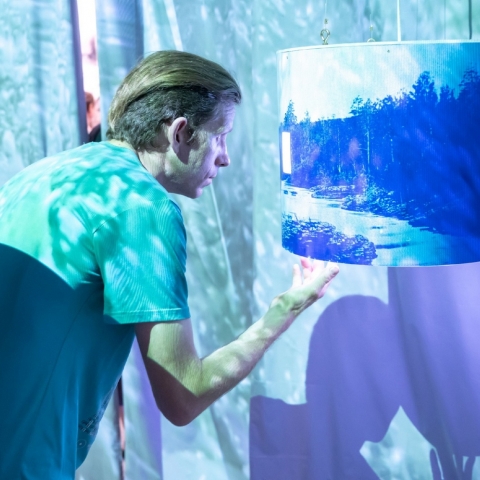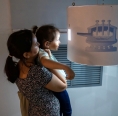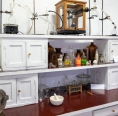-

“Porogi. New Life”
Opening of the exhibition named “Porogi. New Life” devoted to a monument of engineering thought and activity – the first hydroelectric power station built before the Russian revolution – took place in Satka on July 3 in the hall of the Art-Satka building.
The exposition is a result of cooperation of a team from the Satka Museum of Local Lore, specialist in conceptualization of information and researcher Lidia Gumenyuk (St. Petersburg), expositioners Nadezhda Maksimova and Egor Larichev (Poslezavtra architectural and creative agency, Moscow), as well as Technical Director of Magia Magnia company Aleksandr Rychkov.
“This is a very important event for the Satka Museum of Local Lore, as in the future it will move to that building. The exhibition devoted to Porogi became the first one from among those that will be exhibited here in the future”, noted Egor Larichev.
The space of the exhibition is divided into two halls. The first one shows the river up to the levee and a pond. There are four module structures in the form of steps – the rapids to be crossed by the water. Each step contains brief information about construction, development and operation of the Porogi plant. Looking into a small window of a light module, one can learn which circumstances could prevent the construction of the levee.
By the way, as envisioned by the exposition authors, the curtain between two halls is the symbolic image of the levee. Whitewater on a video projected to it is intermitted by images of different drawings.
“Water would remain water, unless a man came to the place of Porogi and brought his ideas and projects. There would be no levee, settlement, plant or ferro-alloys”, explained Nadezhda Maksimova.
The other side of the “levee” shows information on the resources, time and funds spent for the construction. For example, visitors will learn that engineer Boris Bakhmetyev spent four years and six monthsyears to make the project of the levee, and it took 770 days to construct the levee and the plant.
“It is the second hall that uncovers the main idea of our exposition – transformation of energy in all of its aspects. A model made by the students of the South Ural State University under the guidance of Gennady Balandin, demonstrates the transformation of water into electricity. A model furnace – quite a big structure with drawers made of plywood – will help to trace the transformation of materials into ready products. The idea is that on front side we load basic materials like quartz, charcoal, manganese ore, etc., and the name of the smelted product lights up on the end face. And on the rear side of the module we see, where it was supplied and what products were made using it”, explains Elena Kamendrovskaya, a research assistant of the Satka Museum of Local Lore. “The third transformation shows the way from a thought to its implementation with a man in the center. Facts about the life of people in Porogi, their weekdays and holidays, are presented on banners. It’s a great pleasure for me to see those, who helped to gather priceless information about the settlement of Porogi and its residents, among our guests. We will be glad to continue our cooperation.”
One more component of the exhibition space is a chemical laboratory reconstructed from the furniture and special glassware previously owned by the central laboratory of Magnezit. Most part of the showpieces goes back to the first half of the 20th century, and the oldest flask was made in 1913. It is the place, where the first visitors could see a “volcano” formed by a chemical reaction.
“We can tell you a lot about Porogi – one of the most popular monuments in the South Ural and Russia and the most popular tourist location. We can tell you that the Satka Museum of Local Lore won the ‘Industrial Experiment’ competition in the ‘Museum without Limits’ program launched by the Vladimir Potanin Charity Fund. But its result is this exhibition. It tells us about how the transformation of life and history changes our consciousness. It is one of the opportunities to learn more about Porogi, our motherland and meet creative people”, thinks Elena Subbotina, the Head of the Department of Culture of the district.
“We are grateful to everyone, who took part in the preparation of our exhibition. We are grateful to those who created the concept, repaired the site to turn it into the exhibition area, installed electrical equipment, printed and installed banners, renovated furniture, made the showpieces necessary for the exposition. We are grateful to the Magnezit Museum for silicon carbide heaters transferred to our funds, to the Satka Iron Smelting Plant for a sample of manganese ore we lacked, and a book about Porogi, which tells a story of the Porogi plant, a story about training of the future metallurgists of Chelyabinsk at the Porogi plant and development of electrometallurgy in the region”, added Tatiana Titova, the Director of the Satka Museum of Local Lore.
The exhibition is open every day from 9 a.m. until 8 p.m. Admission is free. Excursions by appointment (+79000900510).
Source: Magnezitovets. Photo by: Vasily Maksimov.
-
26.08 - 26.08
DIARY OF THE THIRD INDUSTRIAL BIENNALE
-
28.11 - 28.11
MY SATKA FESTIVAL WINS THE CONTEST OF CORPORATE VOLUNTEER PROJECTS
-
13.10 - 15.10
COOPERATION WITH VGIBL NAMED AFTER M.I. RUDOMINO












